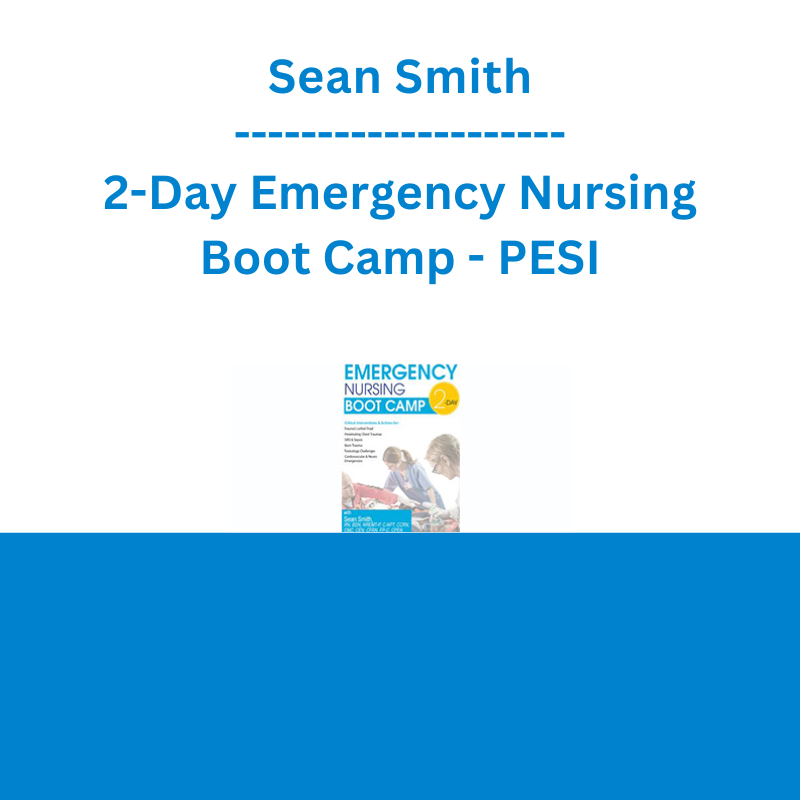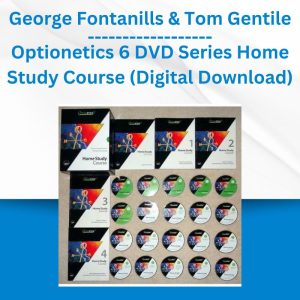*** Proof of Product ***
Exploring the Essential Features of “Sean Smith – 2-Day Emergency Nursing Boot Camp – PESI”
Speaker: Sean G. Smith, MSc, FP-C, C-NPT, CEN, CFRN, CTRN, TCRN, CPEN, CCRN-CMC (Adult), CCRN-K (Neonatal), CCRN-K (Pediatric)
Format: Audio and Video
Media Type: Digital Seminar
Description
Critical Interventions & Actions for:
- Trauma’s Lethal Triad
- Penetrating Chest Traumas
- SIRS & Sepsis
- Burn Trauma
- Toxicology Challenges
- Cardiovascular & Neuro Emergencies
You have the daunting challenge of recognizing subtle changes in a patient’s condition that can lead serious complications or even death. Are you sure you have the knowledge and skills you need to handle these difficult situations?
Working in the rapidly-changing emergency department and caring for the most complex patients means you have to be able to recognize these changes and respond appropriately. You’re dealing with life-threatening conditions and you need to be up to date on the most current and cutting-edge strategies. During this comprehensive program you will gain the skills you need to manage any situation. Drawing on over 20 years of experience, Sean G. Smith, RN, BSN, NREMT-P, C-NPT, CCRN, CMC, CEN, CFRN, FP-C, CPEN, will challenge you to take your knowledge to the next level!
Speaker
Sean G. Smith, MSc, FP-C, C-NPT, CEN, CFRN, CTRN, TCRN, CPEN, CCRN-CMC (Adult), CCRN-K (Neonatal), CCRN-K (Pediatric), is a humanitarian/flight nurse-paramedic who is triple board-certified in neonatal, pediatric, and adult critical care and emergency medicine. He brings 30+ years of education and team/leadership experience to his presentations from a career that includes global health, tropical medicine, research molecular neuroendocrinology, nuclear engineering technology, US Navy aviation/NASA manned space flight support, and high-performance teams/high-yield pedagogy, dozens of national/international conference presentations and various awards and honors. Author/co-author/review credits include a best-selling laboratory medicine textbook, a chapter on shock in Nursing Core Curriculum a section in the newly released Resuscitation Crisis Manual, numerous other industry-standard textbooks, and several professional association critical care/emergency medicine curriculums and board review courses (AACN, ANN, ENA, SCCM, etc.). Additionally, Sean routinely consults on clinical, legal, and certification matters for numerous high-profile hospital systems (Yale, Mayo, etc.). He holds an MSc in Pharmacy/Forensic Science, bachelor’s degrees in business administration, nursing, and molecular biology, and post graduate certificates in Forensic Death Investigation, Legal Consulting, and Tropical Medicine. In addition to being active in a number of professional associations (SCCM, AACN, WADEM, etc.), Sean is a life member of Mensa, The Emergency Nurses Association, and the Air Surface Transport Nurses Association. He has served on the executive committees and in various leadership roles of numerous charities and professional associations and has led/participated in 50+ medical missions (Dominican Republic, Honduras, Morocco, Liberia, Nepal, Iraq, Democratic Republic of Congo, and Haiti). Sean served as a clinician and educator during the largest Ebola and Cholera outbreaks in recent history and is currently active in building sustainable neonatal-pediatric cardiac critical care capacity in Iraq, as well as serving as part of a national-level multidisciplinary child sexual assault forensics team in Guyana, South America. Hobbies include Scuba diving and vintage science kits, tube amplifiers, and motorcycles.
Speaker Disclosures:
Financial: Sean Smith is an independent contractor. He receives a speaking honorarium and recording royalties from PESI, Inc. He has no relevant financial relationships with ineligible organizations.
Non-financial: Sean Smith is a member of the American Association of Critical Care Nurses, the Emergency Nurses Association, and the Society for Critical Care Medicine.
Outline
OUTLINE – DAY ONE
Trauma’s Lethal Triad: Hypothermia, Acidosis & Coagulopathy Hypothermia
- Correct Classification of the Trauma Patient
- Contributing Risk Factors
- Volume Resuscitation
Why, When & How to Use IV Fluids
Acidosis
- What is Happening & Why?
- Panic Values & Lethal Levels
- Oxyhemoglobin Dissociation Curve
Left & Right Curves
Why it Matters
Coagulopathies
- Understanding a Very Complex Process
- Effect on Body Systems
- When it Goes Wrong
- DIC: Disseminated Intravascular Coagulopathy
Understanding the Lab Values
– CBC, Platelets, PT, PTT, D-dimer, Fibrin
Hemorrhagic Shock
– Permissive Hypotension
Damage Control Resuscitation
Putting it All Together
- Simple Steps that SAVE Lives
- Management & Treatment Options
Burn Trauma
- Critical Assessments during the Primary Survey
- Key Components of the Secondary Survey
- Fluid Resuscitation Formulas
- American Burn Association Evaluation Criteria
- Treatment Strategies for Chemical, Electrical & Thermal Burns
- ‘Never Miss’ Clues for Identifying Inhalation Injuries
The Septic Patient
- SIRS: Systemic Inflammatory Response Syndrome & SEPSIS
- Inflammatory Response: A Good Thing
- SIRS: Too Much of a Good Thing
- Sepsis & Severe Sepsis: Too Much of a Good Thing Comes to a Bad End
- Patient Presentations along the Continuum
Sepsis Surveillance
Emergent Interventions: Time is Tissue
OUTLINE – DAY TWO
Penetrating Chest Traumas
- FAST Evaluation & Ultrasound
- Pneumothorax
Variations & Identifying Symptoms
Emergency Interventions - Flail Chest
Dos & Don’ts of Initial Management
Special Populations at Risk - Cardiac Tamponade
Thoracotomy in the ED
Cardiovascular Emergencies
- Advanced Hemodynamics
SVR: Systemic Vascular Resistance
CVP Monitoring - The Spectrum of Acute Coronary Syndrome
Key Assessments & Interventions for:
Unstable Angina
STEMI
Non-STEMI - Recognizing Arrhythmias
Stable, Unstable and Lethal
Neuro Emergencies: Time is Brain
- Concepts of Volume & Pressure
- Rapid Neuro Assessment
- Critical Interventions for:
TBI
Spinal Cord Injuries
Diffuse Axonal Injury
Toxicology Challenges
- Identifying the Toxin
- Assessment of Intentional & Unintentional Overdose
- ABGs – a Critical Key
- Treatment Options: Removing & Reducing Causative Agent
- Symptom Management Strategies When There is No Curative Agent
- Toxicology Arrhythmias: Expected & Unexpected
- Today’s Street Drugs
Life-Threatening Electrolyte Imbalances
- Critical Clues for Quick Identification
- Panic Values
- Interventions that Improve Outcomes
- Potential Causes & Treatments
Objectives
- Interpret patterns of ischemia, injury and infarction on a 12-lead EKG.
- Discuss cardiac disorders which carry an increased risk for sudden death.
- Describe the relationship between ventilation and perfusion.
- Identify conditions which would require a chest tube.
- Recognize assessment findings in clinical syndromes that may progress rapidly and cause life-threatening conditions.
- Define the anatomy and physiology of the neurological system and how this manifests in physical symptoms.
- Recognize life-threatening electrolyte imbalances, potential causes and remedies.
- Interpret arterial blood gasses using a three-step method.
- Compare and contrast the oxyhemoglobin dissociation curve to pulse oximetry readings, So2 and pO2 values.
- Evaluate signs, symptoms and treatment modalities for four different classifications of shock.
- Describe systemic inflammatory response syndrome and the spectrum of septic shock.
- Correlate clinical presentations of patients during the continuum of SIRS to septic shock.
- Discuss the coagulation cascade and laboratory values associated with disruption of normal function.
Target Audience
- Nurses.
Please see the full list of alternative group-buy courses available here: https://lunacourse.com/shop/










 Racing Workshop - Complete Online Package
Racing Workshop - Complete Online Package  Greg Loehr - Advanced Option Trading With Broken Wing Butterflies
Greg Loehr - Advanced Option Trading With Broken Wing Butterflies  Fred Haug - Virtual Wholesaling Simplified
Fred Haug - Virtual Wholesaling Simplified  Production Tips - Bootcamp (Dec 23 - Jan 24)
Production Tips - Bootcamp (Dec 23 - Jan 24)  Forexmentor - Recurring Forex Patterns
Forexmentor - Recurring Forex Patterns  The Daily Traders – Exclusive Trading Mentorship Group
The Daily Traders – Exclusive Trading Mentorship Group  Matthew Kratter - Trader University
Matthew Kratter - Trader University  James E. Hughes Jr. & Susan E. Massenzio & Keith Whitaker - Complete Family Wealth (Bloomberg) (Kindle)
James E. Hughes Jr. & Susan E. Massenzio & Keith Whitaker - Complete Family Wealth (Bloomberg) (Kindle)  Jesse Livermore Trading System - Joe Marwood
Jesse Livermore Trading System - Joe Marwood  George Fontanills & Tom Gentile - Optionetics Wealth Without Worry Course
George Fontanills & Tom Gentile - Optionetics Wealth Without Worry Course  SMB - Options Training
SMB - Options Training  Sovereign Man Confidential - Renunciation Video
Sovereign Man Confidential - Renunciation Video  Atlas API Training - API 570 Exam Prep Training Course
Atlas API Training - API 570 Exam Prep Training Course  Mark Kobayashi-Hillary - Building Future with BRICs
Mark Kobayashi-Hillary - Building Future with BRICs  Emanuele Bonanni - My Trading Way
Emanuele Bonanni - My Trading Way